The Hanoi Old Quarter Night Market is a vibrant and bustling weekend attraction located in the heart of Hanoi’s historic Old Quarter. It operates every Friday, Saturday, and Sunday from 6 pm to 11 pm, transforming the narrow streets into a lively marketplace filled with local vendors, street food, entertainment, and cultural performances.
Watch the video summarizing the article “Hanoi Old Quarter Night Market: Enjoy Shopping and Dining”
As you step into the market, you are greeted by a captivating array of wares from traditional handicrafts and textiles to contemporary souvenirs and accessories. The market stretches along several streets, including Hang Ngang, Hang Dao, Hang Buom, and Luong Ngoc Quyen, creating a vibrant and immersive atmosphere. This location, nestled near Hoan Kiem Lake, provides a convenient and picturesque backdrop for market exploration.One of the highlights of the Hanoi Old Quarter Night Market is the opportunity to indulge in authentic Vietnamese street food. The tantalizing aromas of sizzling dishes and the lively sounds of cooking fill the air, inviting visitors to sample a wide range of local delicacies, from the iconic pho to savory banh mi sandwiches. As the sun sets, the market transforms with the glow of multicolored lights, creating a magical and enchanting ambiance.
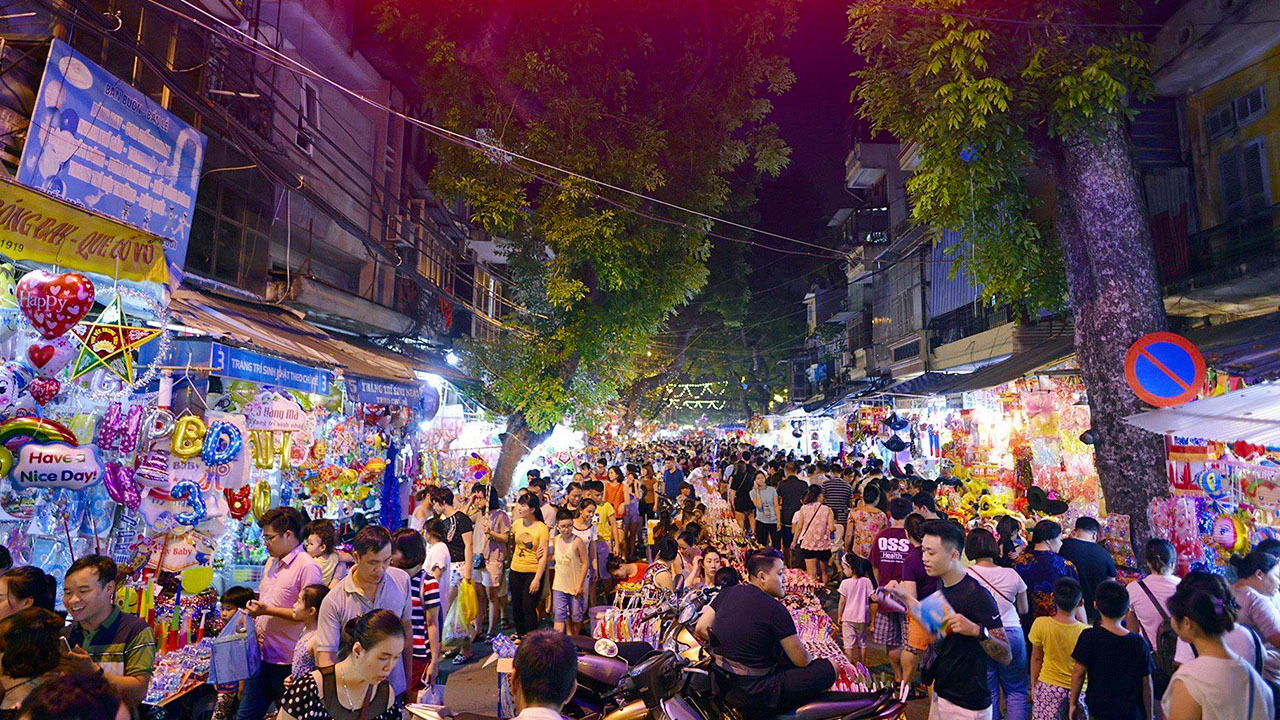
Street performers showcase their talents, adding to the lively and energetic atmosphere. Bargaining is an integral part of the shopping experience at the Hanoi Old Quarter Night Market, allowing visitors to engage with local vendors and immerse themselves in the local culture. This time-honored tradition fosters a sense of camaraderie and provides an opportunity to connect with the local community.
In conclusion, the Hanoi Old Quarter Night Market is a must-visit destination that epitomizes the vibrant spirit of Hanoi. It offers a captivating blend of traditional and modern elements, providing visitors with an unforgettable cultural experience and a glimpse into the rich heritage of the city.
Location and Accessibility to Hanoi Old Quarter Night Market
Situated in the heart of Hanoi’s historic Old Quarter, the Hanoi Old Quarter Night Market’s location couldn’t be more strategic. The market runs along some of the busiest streets, including Hang Ngang, Hang Dao, and Dong Xuan Market, forming a bustling thoroughfare that captures the essence of Vietnamese street life. As the sun sets, these streets are closed to vehicles, making them accessible only to pedestrians.
This central location makes the night market exceedingly accessible whether you are a local or a tourist. Most landmarks and popular hotels are within walking distance. For those staying near Hoan Kiem Lake, a short stroll takes you right into the thick of the action. Public transportation options are plentiful, with numerous bus lines and traditional cyclos providing convenient trips to the market. Motorbikes and bicycles are also popular means of getting to the market, although you may need to park them a little further from the entrance due to the crowded streets.

For tourists arriving from farther afield, the proximity to the Long Bien Railway Station is another plus. This station is only a short distance away, making the market highly accessible for day-trippers exploring other parts of Vietnam by train. Taxis and ride-hailing services such as Grab are widely available and can drop you off at one end of the market before you leisurely stroll through the bustling streets.
Navigating through the market can initially seem overwhelming due to the sheer number of people and stalls. However, once inside, the market is relatively straightforward to explore. Each street has its own unique character and specializes in different types of goods, from clothes and accessories to electronics and handicrafts. The layout ensures that you won’t miss out on anything, whether you’re specifically there to hunt for bargains or simply to soak in the atmosphere.
In summary, the Hanoi Old Quarter Night Market’s central location and excellent accessibility options make it a must-visit attraction. Whether you’re a local Hanoian or a traveler from halfway around the world, getting to this vibrant space is relatively hassle-free, setting the stage for an exhilarating experience once you arrive.
Operating hours
The operating hours of the Hanoi Old Quarter Night Market are meticulously planned to maximize visitors’ enjoyment while aligning with the bustling nature of Hanoi’s nightlife. The market is an exclusive weekend affair, operating every Friday, Saturday, and Sunday evening from 6 pm to 11 pm. The designated timing underscores the market’s role as a weekend retreat for locals and tourists alike.

From the moment the clock strikes six, the streets of the Old Quarter start to transform. Vendors rush to set up their stalls, and the market gradually evolves from the typical daytime chaos of Hanoi’s streets into a captivating nighttime spectacle. For locals, Friday night marks the start of the weekend, and the market becomes a social gathering point, teeming with camaraderie and the bustle of commerce.
Operating within this time frame, the market capitalizes on the cooler evening temperatures, making it a more pleasant experience for visitors. It’s important to note that arriving early can sometimes mean getting the first pick of unique items from the vendors. On the flip side, an arrival closer to the closing time might offer the best bargains, as sellers are often more willing to lower prices to close a sale.
In these five-hour windows, visitors have ample opportunity to explore the diverse array of goods on offer, feast on the myriad of street food specialties, and enjoy live performances that add to the market’s mesmerizing vibe. While the official closing time is 11 pm, the energy often lingers on, with visitors gradually dispersing, and vendors packing up their stalls, ready to repeat the process the following night.
In conclusion, the designated operating hours from 6 pm to 11 pm every weekend ensure a dynamic and enjoyable experience at the Hanoi Old Quarter Night Market. These timings allow for a perfect evening filled with shopping, gastronomy, and cultural engagement, making every visit a cherished memory.
History of the night market
Establishment and growth
The Hanoi Old Quarter Night Market is more than just a commercial hotspot; it’s a living testament to the city’s long history of trade and craftsmanship. The roots of the night market can be traced back to the 15th century, during a time when Hanoi’s Old Quarter was already established as a bustling commercial district. Craftsmen and merchants from surrounding villages would flock to the markets to sell their wares, setting up shops and stalls along the narrow, meandering streets. This rich history of commerce laid the foundation for what the night market is today.
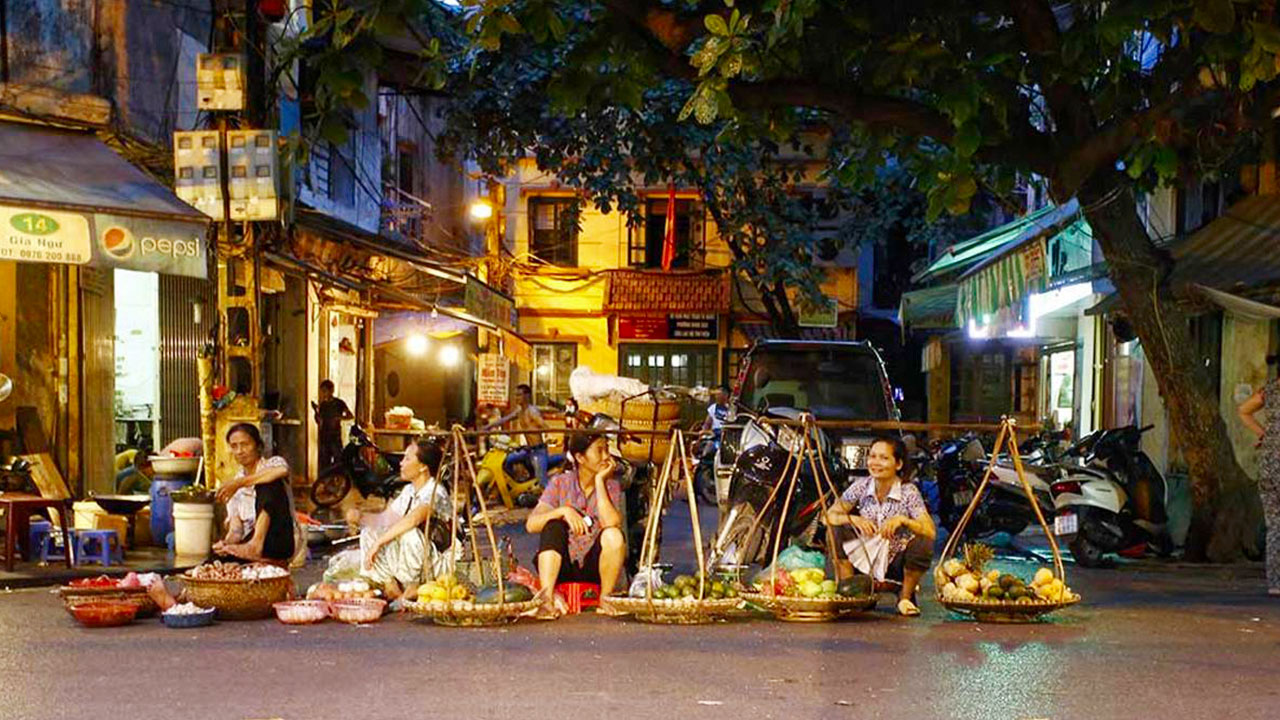
Initially, each street specialized in selling particular goods a tradition that still echoes in today’s market. Streets named after the products they sold, such as Hang Bac (Silver Street) and Hang Dao (Silk Street), provide a fascinating glimpse into the past. These historical practices have carried over into the present, making the market a unique blend of old and new.
In the modern era, the night market formalized and expanded significantly. Once a simple collection of stalls, it has now grown into a sprawling marketplace that draws thousands of visitors each weekend. The Vietnamese government recognized the cultural and economic value of the night market, leading to various initiatives aimed at preserving its historical essence while promoting its growth. Special layouts, regulations, and promotional events have all contributed to making the market one of Hanoi’s top tourist destinations. According to a 2020 report by the Hanoi Department of Tourism, the night market attracts an estimated 20,000 visitors each weekend.
With the rise of globalization and Hanoi’s increasing popularity as a tourist hotspot, the market has adapted by diversifying its offerings. You can now find a mix of traditional handicrafts and modern consumer goods, catering to both international tourists and local residents. However, despite its growth and modernization, the market retains its original charm, reflecting Hanoi’s rich cultural tapestry.
In conclusion, the establishment and subsequent growth of the Hanoi Old Quarter Night Market are rooted in centuries-old traditions of craftsmanship and trade. Through modernization efforts and government support, the market has evolved into a symbol of Hanoi’s enduring commercial and cultural significance.
Cultural significance
The cultural significance of the Hanoi Old Quarter Night Market goes beyond its role as a bustling marketplace. It serves as a vibrant cultural crossroads that encapsulates the rich heritage of Vietnam. Each weekend, as the market buzzes with activity, it becomes a living canvas, portraying the confluence of tradition and modernity, local life and global influences.
Traditionally, the Old Quarter has been the pulse of Hanoi, a community built around artisanship and commerce. This historical essence flows seamlessly into the night market, where visitors can observe centuries-old crafts and practices still thriving. For instance, you’ll find artisans weaving silk, crafting pottery, and carving wood, offering tangible connections to the past. This continuity not only preserves cultural traditions but also imparts them to younger generations and curious tourists.
Additionally, the market is a key venue for various traditional Vietnamese festivities and celebrations. During the Mid-Autumn Festival, the night market transforms with vibrant lanterns, cultural displays, and traditional music, enhancing its role as a cultural epicenter. The symbiotic relationship between cultural events and the market underscores its significance in the fabric of Hanoi’s social and cultural life.
The night market also provides an invaluable platform for local artists and performers. Street performances range from traditional music and dance to contemporary acts, capturing both the historical and evolving cultural landscape of Vietnam. These performances aren’t just entertainment; they are expressions of Vietnamese identity and creativity. According to a 2019 study published in the “Journal of Vietnamese Studies,” such performances at the market have played a crucial role in reviving interest in traditional Vietnamese arts among younger generations.
From a socio-economic perspective, the market acts as a linchpin for the local economy. It supports countless vendors, craftsmen, and small enterprises, providing them with a sustainable livelihood. Moreover, it fosters a sense of community and belonging among vendors and frequent visitors, building social capital.
In summarizing its cultural significance, the Hanoi Old Quarter Night Market is a dynamic space where tradition meets modernity. It represents a microcosm of Vietnamese heritage, offering a living museum of crafts, performances, and local life. For both locals and tourists, the market is not just a place to shop but a venue to experience and appreciate the rich cultural tapestry of Hanoi.
Market experience
Atmosphere and vibrancy
Stepping into the Hanoi Old Quarter Night Market is a sensory overload in the best possible way. As the sun sets and the market springs to life, you are immediately enveloped by a kaleidoscope of sights, sounds, and smells. The atmosphere is electric, a vibrant blend of historical charm and contemporary vigor that captures the essence of Hanoi itself.

The streets are adorned with multicolored lights that glint and shimmer, casting a magical glow over the entire marketplace. Neon signs intermingle with traditional lanterns, creating an enchanting blend of old and new. Local vendors enthusiastically call out to passersby, engaging in spirited bargaining sessions that are as much a part of the experience as the goods themselves. The animated chatter of buyers and sellers mixes with the ambient sounds of sizzling street food, creating a symphony of hustle and bustle.
Comparing this to a daytime market or commercial shopping street, the night market stands out for its unique atmosphere. While daytime markets may offer a less crowded, more leisurely shopping experience, they often lack the vibrant, festive energy that comes alive in the night market. The evening setting provides a cooler, more comfortable backdrop, encouraging both visitors and locals to linger, explore, and immerse themselves in the surroundings.
Another striking aspect is the mix of people. The market draws an eclectic crowd: from young locals looking for trendy fashions and tourists hunting for unique souvenirs to families savoring an evening out and elderly couples reminiscing about the past. This diverse throng contributes to a dynamic and inclusive environment.
The vibrancy is further augmented by street performances, which range from traditional Vietnamese music and dance to modern busking acts. These performances add layers of cultural richness to the experience, enhancing the market’s engaging and animated vibe.
In essence, the atmosphere and vibrancy of the Hanoi Old Quarter Night Market are incomparable, offering an experience that transcends mere shopping. It is a genuine cultural extravaganza, an immersive glimpse into the heart of Hanoi’s rich heritage and dynamic contemporary culture.
Culinary delights
Popular street foods
Hanoi is renowned for its street food, and the Old Quarter Night Market is a gastronomic paradise where you can sample some of the city’s best offerings. The tantalizing aromas of various foods wafting through the air lure you to different stalls, each offering a unique taste of Vietnamese cuisine. Here, the fusion of various regional flavors and traditional recipes creates a culinary experience that is truly memorable.
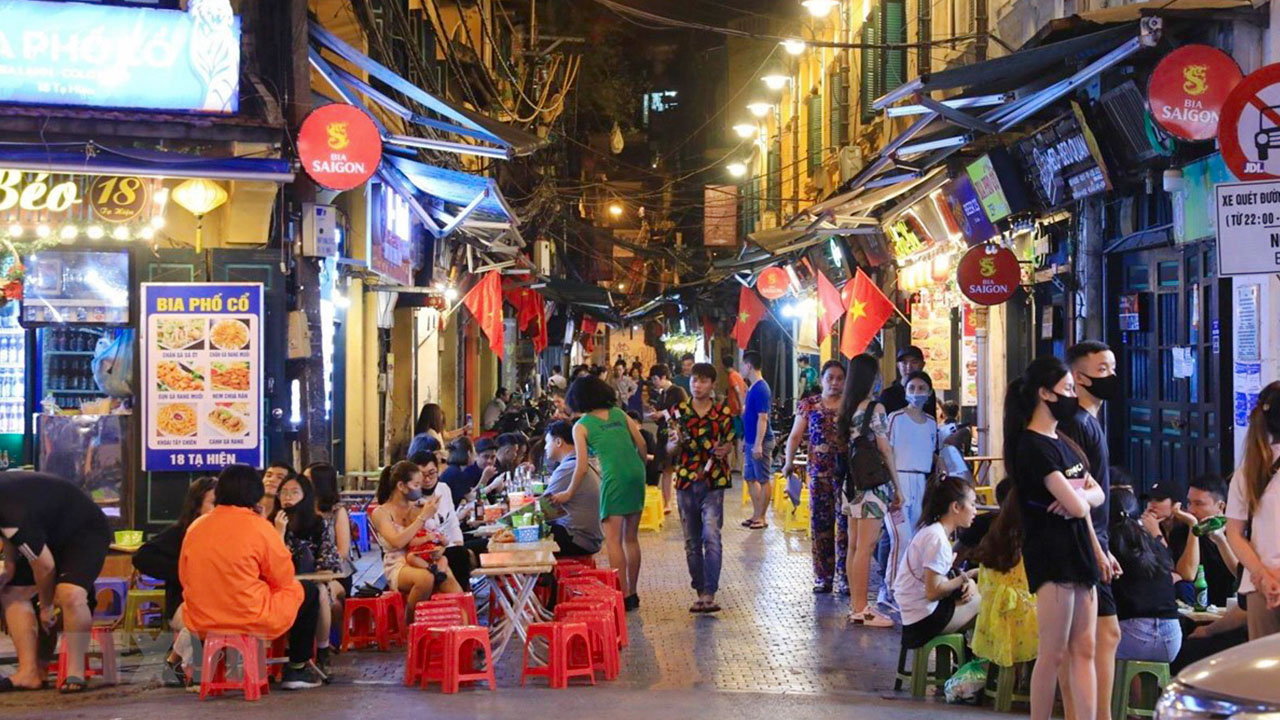
One of the most iconic dishes you must try is pho. This traditional Vietnamese soup, made with rich, aromatic broth, rice noodles, and either beef or chicken, is a staple. At the night market, you can watch as vendors expertly prepare bowls of pho right in front of you, making the experience both delicious and interactive. When compared to having pho in a standard restaurant setting, the street market version offers an extra layer of authenticity and immediacy, enhancing the overall experience.
Another beloved option is banh mi, the Vietnamese sandwich that has won hearts worldwide. Banh mi stalls at the night market serve up baguettes filled with a variety of ingredients like pate, mayonnaise, pickled vegetables, and different meats. The result is a crunchy, flavorful bite that’s both satisfying and portable a perfect snack as you continue your shopping journey.
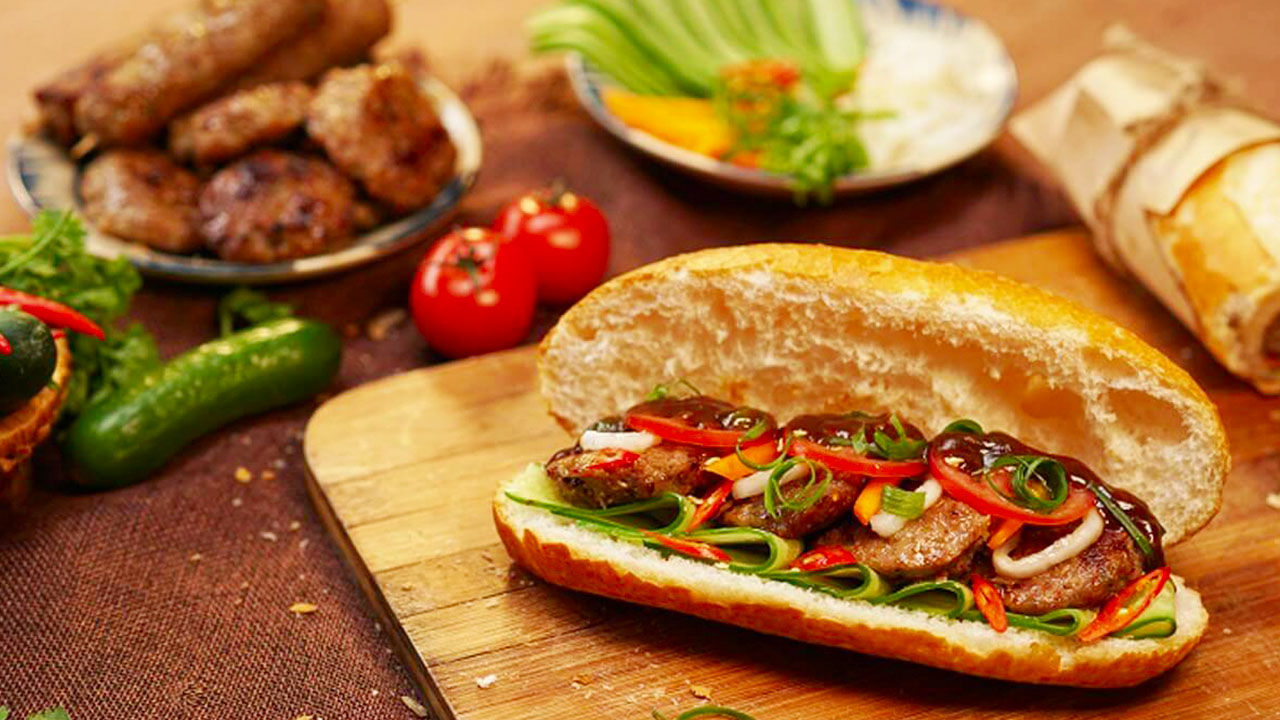
Spring rolls, both fried (cha gio) and fresh (goi cuon), are also ubiquitous and a must-try. These rolls, filled with either minced pork and vegetables or fresh shrimp and herbs, offer a delightful contrast in textures and flavors. They are often served with a tangy dipping sauce that perfectly complements their taste.
For those with a sweet tooth, don’t miss out on che, a traditional Vietnamese dessert. Che encompasses a variety of dishes, but at the night market, you’re likely to find stalls offering sweet soups and puddings made with ingredients like mung beans, coconut milk, and tapioca. It’s a refreshing end to a meal and a delightful way to cool down after navigating the bustling market.
The night market’s culinary delights offer a comprehensive sampling of Hanoi’s famed street food culture. The experience of trying these dishes amidst the vibrant, street-side setting elevates their taste and creates lasting memories.
Unique beverages
The culinary experience at the Hanoi Old Quarter Night Market is not confined to its delectable dishes. The market also boasts a variety of unique beverages that complement the street food and add another layer of enjoyment. Just as the food stalls lure you with tantalizing aromas, so too do the drink vendors, offering concoctions that are both refreshing and inventive.
One of the quintessential beverages to try is bia hoi, Vietnam’s famous draft beer. Bia hoi is a light, refreshing brew that pairs perfectly with the salty and savory street food. Many vendors offer seats where you can relax and enjoy your beer while soaking in the market’s effervescent atmosphere. Unlike bottled or canned beers, bia hoi is brewed daily and delivered in kegs, making it exceptionally fresh. When you compare it to more commercial or even craft beers, bia hoi offers a simplicity and freshness that’s hard to beat.

For those who prefer non-alcoholic options, nuoc mia is a must-try. This sugarcane juice, typically extracted fresh on-site, is both sweet and refreshing. Served over ice, it’s the perfect thirst quencher on a warm evening. Its natural sweetness and lightness make it a healthier alternative to sodas and other sugary drinks.
Vietnamese iced coffee, or ca phe sua da, is another crowd favorite. This strong, robust coffee, mixed with sweetened condensed milk and served over ice, provides the perfect pick-me-up as you navigate the crowded market. The combination of bitter coffee and sweet milk offers a balanced, flavorful experience that’s distinctly Vietnamese.
For something a bit more adventurous, try a blend of che, the traditional Vietnamese sweet dessert soups which can also be served cold. Variants like che ba mau (three-color dessert) or che thap cam (mixed dessert) are particularly popular. These cold, sweet treats include layers of beans, jellies, and coconut milk, offering a refreshing and intriguing flavor profile.
In summary, the unique beverages at the Hanoi Old Quarter Night Market add yet another dimension to its culinary wonders. Whether you’re looking for a refreshing drink to cool off or a strong coffee to keep you energized, the market offers an array of choices that cater to every palate. These drinks not only accompany the food perfectly but also stand as delightful experiences in their own right.
Shopping at the night market
Types of goods available
Handicrafts and souvenirs
The Hanoi Old Quarter Night Market is a treasure trove for anyone interested in authentic Vietnamese handicrafts and souvenirs. As you wander through the colorful labyrinth of stalls, you are greeted by an array of items that reflect the rich cultural heritage and artisanal skill of the region. From intricately designed lacquerware to handwoven textiles, the market is a veritable showcase of Vietnam’s artisanal prowess.

One of the most popular categories of goods available is lacquerware. These beautifully crafted items, ranging from bowls and plates to intricate paintings, are made using traditional techniques that date back hundreds of years. The lacquer is applied in multiple layers and polished to a high gloss, creating pieces that are not only functional but also aesthetically stunning. Comparatively, similar items found in standard retail shops often lack the authenticity and intricate workmanship displayed in those at the night market.
Another sought-after item is silk products. You’ll find everything from silk scarves and ties to bed linens and clothing. Hanoi has a long history of silk production, and the night market offers a chance to purchase pieces directly from local artisans. The quality of the silk is often superior to what you might find in tourist shops, and the prices are typically more reasonable.
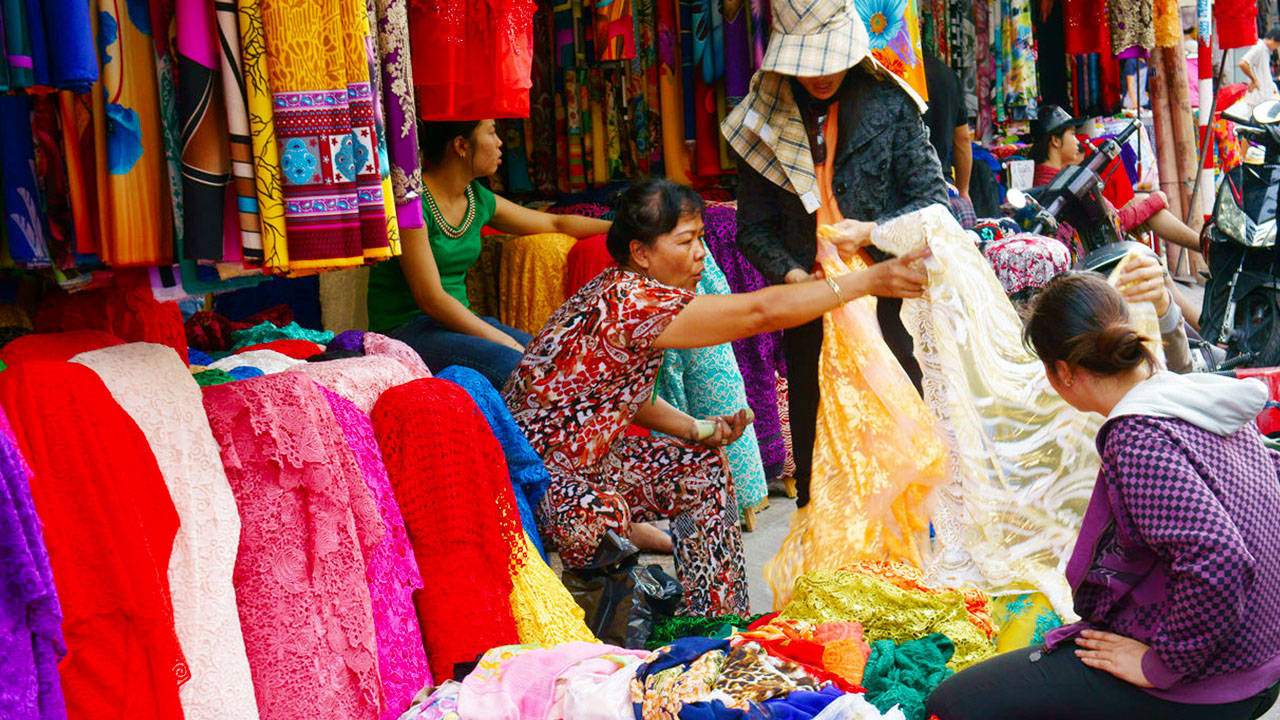
Wooden toys and bamboo crafts are also staples at the market. Items like bamboo dragonflies, wooden puzzles, and traditional puppets make for charming, unique souvenirs. These crafts often carry the essence of Vietnamese culture and folklore, serving as keepsakes that are both decorative and meaningful. When compared to mass-produced souvenirs, the handmade quality of these items adds a special touch that is hard to replicate.
For those interested in jewelry, the market offers a variety of traditional Vietnamese silver and jade pieces. From rings and necklaces to bracelets and earrings, these items often incorporate traditional motifs and designs. Although similar pieces can be found in jewelry shops, the night market offers a wider range and better prices, making it an excellent place to find unique and affordable jewelry.
In conclusion, the Hanoi Old Quarter Night Market excels in offering high-quality handicrafts and souvenirs. These items not only serve as mementos of your visit but also provide a tangible connection to Vietnamese culture and craftsmanship. Whether you’re shopping for yourself or looking for gifts, the market offers a diverse array of beautifully made, authentic products.
Clothing and accessories
Clothing and accessories are another major highlight at the Hanoi Old Quarter Night Market. From fashionable attire to practical everyday wear, the market offers a variety of options that cater to different tastes and needs. The vibrant stalls are filled with an impressive range of items that reflect both traditional Vietnamese fashion and contemporary styles.
One popular category is Vietnamese silk clothing. Silk dresses, blouses, and scarves are abundant, showcasing intricate designs and high-quality fabric. Silk is a staple of Vietnamese fashion, known for its lightness, softness, and durability. When compared to mass-produced garments, the silk clothing at the night market offers a touch of luxury and authenticity, providing a unique addition to any wardrobe.
Street fashion is also well-represented. You’ll find a variety of trendy clothes that are not only fashionable but also affordable. From graphic t-shirts and jeans to stylish dresses and skirts, the market offers an array of options that reflect the latest trends. The prices for these items are often more reasonable than those in retail shops, making it a budget-friendly shopping destination.
Accessories such as handbags, wallets, and belts are also popular items. These come in various materials including leather, faux leather, and even eco-friendly options like bamboo and rattan. Handmade bags andaccessories often showcase traditional Vietnamese patterns and designs, adding a unique flair that sets them apart from generic factory-made products. When you pick up a handcrafted leather wallet or an intricately woven bamboo handbag from the market, you’re not just buying an accessory, but a piece of art infused with cultural significance.
For those looking for functional yet stylish footwear, the market offers a variety of shoes and sandals. From traditional handcrafted sandals to modern sneakers, the choices are diverse. A popular item to look out for are the hand-embroidered shoes that reflect Vietnamese motifs and craftsmanship. These unique pieces often come at a fraction of the cost you’d expect in high-end stores, making them an excellent value for your money.
In addition to traditional clothing items, the market also offers contemporary and sportswear options. Tracksuits, activewear, and branded sneakers can be found at competitive prices, providing a wide range of choices for those looking for more practical or sporty attire.
One standout feature of the clothing and accessories section at the Hanoi Old Quarter Night Market is the availability of customized items. There are several stalls where tailors can customize pieces to fit you perfectly, adding an extra layer of personalization to your shopping experience. This is a unique offering that sets the market apart from conventional retail stores.
Overall, the diversity of clothing and accessories at the Hanoi Old Quarter Night Market provides something for everyone, whether you’re seeking traditional Vietnamese outfits or contemporary fashion items. The market not only offers a varied and high-quality selection but also imbues each purchase with cultural authenticity and individuality.
The art of bargaining
Bargaining is an integral and almost ritualistic part of the Hanoi Old Quarter Night Market experience. Unlike fixed-price retail stores, the market thrives on the dynamic interaction between buyers and sellers, adding an element of excitement and engagement to the shopping process. Understanding how to bargain effectively can make the difference between paying a higher price and securing a good deal.
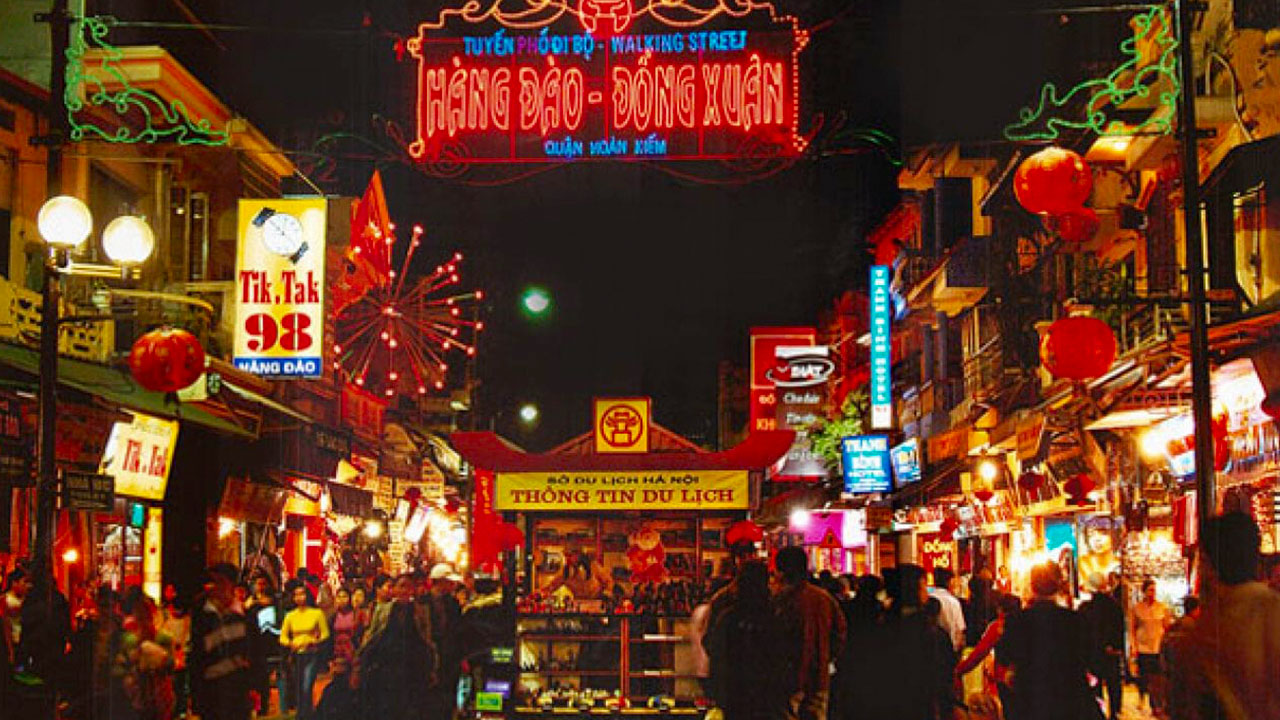
To begin with, it’s important to approach bargaining with a positive attitude. Vendors expect some haggling, and it’s considered a normal part of the shopping experience. Start by offering a price that is significantly lower than what the vendor has quoted, but not so low that it could be seen as disrespectful. Typically, offering around 60-70% of the asking price is a good starting point. The vendor will counter-offer, and the negotiation can proceed from there.
Use easy-to-understand metaphors and emotional language to build rapport with the seller. For example, if a seller quotes 150,000 VND for an item, you might say, “How about 100,000 VND? I’m buying for my children, and I really love your work.” This approach personalizes the interaction and shows that you value the item and the vendor’s craftsmanship.
Another tactic is to buy multiple items from the same vendor. Vendors are often more willing to offer discounts for bulk purchases. Suppose you find a set of silk scarves and a lacquerware bowl that you like. Instead of buying them separately, try negotiating a combined price. This not only makes the vendor more inclined to offer a discount but also allows you to bundle your purchases, making the bargaining process smoother.
It’s also useful to shop around and familiarize yourself with the average prices of items. Having a baseline understanding of what a reasonable price is can help you gauge how far you can negotiate. For example, if you see that most silk scarves are priced around 200,000 VND, you’ll have a better idea of what to aim for when bargaining.
Be prepared to walk away if the price doesn’t meet your expectations. Often, vendors will call you back with a better offer if they sense that they might lose a sale. However, always remain respectful and polite; remember that vendors are trying to make a living too.
In summary, mastering the art of bargaining enhances the overall market experience and allows you to engage more deeply with the local culture. It’s an interactive, enjoyable, and often rewarding aspect of shopping at the Hanoi Old Quarter Night Market.
Activities at the night market
Street performances
One of the most enchanting aspects of the Hanoi Old Quarter Night Market is the diverse range of street performances that occur nightly. These performances add a vital layer of entertainment and cultural immersion, transforming an ordinary shopping trip into a vibrant, multifaceted experience. Whether you’re drawn to traditional Vietnamese music or modern-day busking artists, the night market has something to captivate everyone.
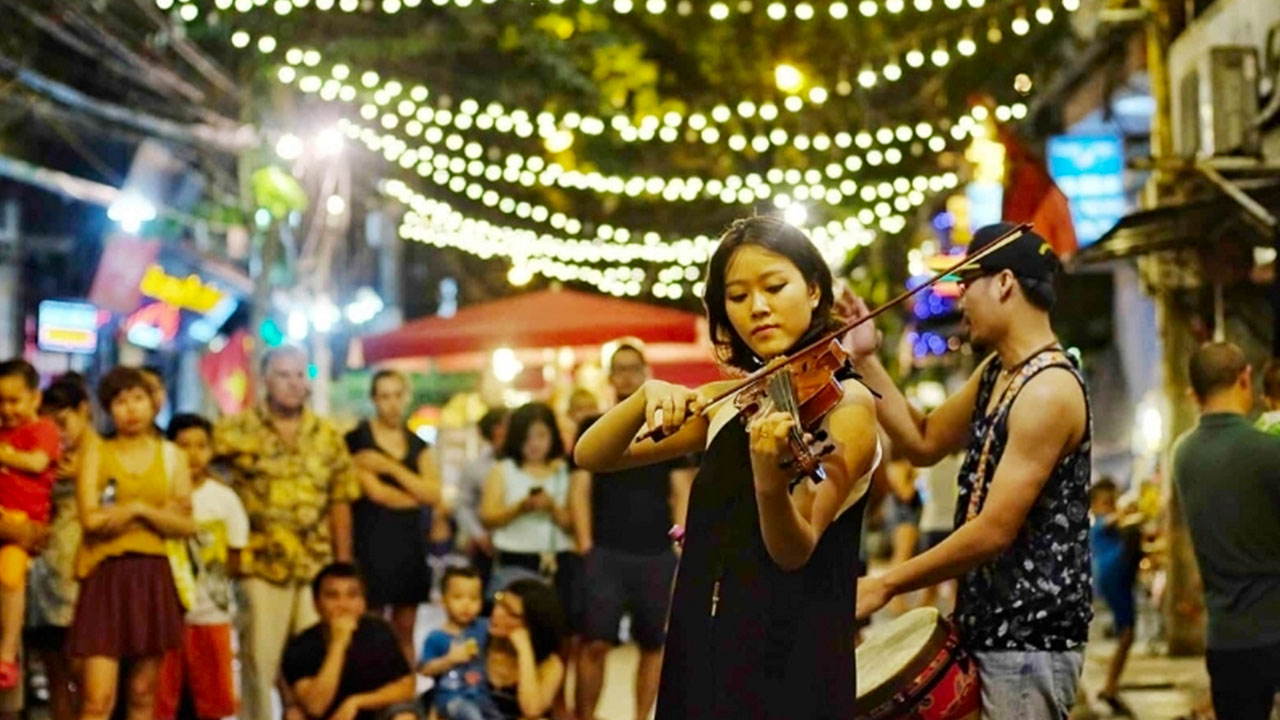
Traditional Vietnamese music and dance performances are a common sight at the market. Musicians playing traditional instruments such as the dan bau (a single-string instrument) or the t’rung (a bamboo xylophone) mesmerize audiences with their skill. Often, these performances are accompanied by traditional dance routines, bringing Vietnamese folklore and history to life. The rhythm and melody create an ambiance that transports you back to ancient Vietnam, enriching your cultural experience.
Comparatively, modern street artists and buskers infuse the night with contemporary flair. From acoustic guitarists and solo singers to dance troupes performing hip-hop routines, the variety is astounding. These performances often draw large crowds, creating an engaging, high-energy atmosphere. Unlike traditional music, which connects you with Vietnam’s cultural roots, these modern performances offer a glimpse into the country’s evolving artistic landscape.
A particularly interesting feature of the street performances is the puppetry shows. Water puppetry is a unique Vietnamese art form that originated in the Red River Delta and has been performed for centuries. At the night market, you can often find small-scale water puppet shows featuring puppets dancing on water to the music of traditional instruments. These shows are both entertaining and educational, providing a fascinating window into traditional Vietnamese entertainment.
Additionally, street magicians and acrobats add an element of surprise and wonder. Watching a magician pull off a trick or seeing an acrobat perform gravity-defying stunts keeps the night exhilarating and unpredictable. These performances contribute to a carnival-like atmosphere that enthralls both adults and children alike.
In conclusion, the street performances at the Hanoi Old Quarter Night Market elevate it from a mere shopping destination to a vibrant cultural venue. From traditional music and dance to contemporary performances and puppetry shows, these artistic displays add layers of enjoyment that make every visit to the market an unforgettable experience.
Cultural exhibitions
Cultural exhibitions at the Hanoi Old Quarter Night Market are another significant draw, adding depth and context to your visit. These exhibitions often showcase traditional Vietnamese crafts, art, and history, providing an educational and immersive experience that complements the market’s vibrant atmosphere.
One of the main attractions is the live demonstration of traditional Vietnamese crafts. Artisans set up booths where they work on their crafts in real-time, allowing visitors to observe and engage with the process. For example, you might find a silk weaver painstakingly threading fabric on an ancient loom or a master calligrapher creating beautiful Vietnamese script on rice paper. These demonstrations offer a deeper appreciation of the craftsmanship involved and provide an opportunity for meaningful interaction between the artisan and the audience.
Photography exhibitions and historical displays also enrich the market experience. Photos capturing Hanoi’s past, along with exhibits featuring ancient artifacts, give visitors a glimpse into the city’s storied history. By understanding the historical context and cultural background, visitors can connect more profoundly with the items they purchase and the overall experience. For instance, discovering the history behind a particular type of pottery or fabric can make a souvenir feel more significant and cherished.
It’s not uncommon to find themed cultural exhibitions tied to specific Vietnamese festivals and holidays as well. For example, during the Tet Lunar New Year, there may be exhibitions showcasing Tet customs, traditional foods, and decorations. These themed displays add layers of cultural richness, making the market a hub of activity that reflects Vietnam’s festive spirit and traditions.
Interactive folk games are another highlight. Stalls with traditional Vietnamese games like “ò ăn quan” (a strategic game using small stones or seeds) or “đánh đu” (bamboo swing games) provide an engaging way to learn about local traditions. These games aren’t just a form of entertainment; they’re a tactile connection to Vietnam’s heritage, allowing both locals and tourists to participate actively in its cultural legacy.
In summary, cultural exhibitions enrich the Hanoi Old Quarter Night Market experience by providing educational and immersive elements that extend beyond commerce. Whether through live craft demonstrations, historical displays, or interactive games, these exhibitions add depth and context, making your visit not just enjoyable but also enlightening.
Tips for visitors
Best times to visit
The Hanoi Old Quarter Night Market is a weekend extravaganza, operating every Friday, Saturday, and Sunday from 6 pm to 11 pm. Given its popularity, timing your visit well can greatly enhance your experience, allowing you to enjoy the vibrant atmosphere without getting overwhelmed by crowds.
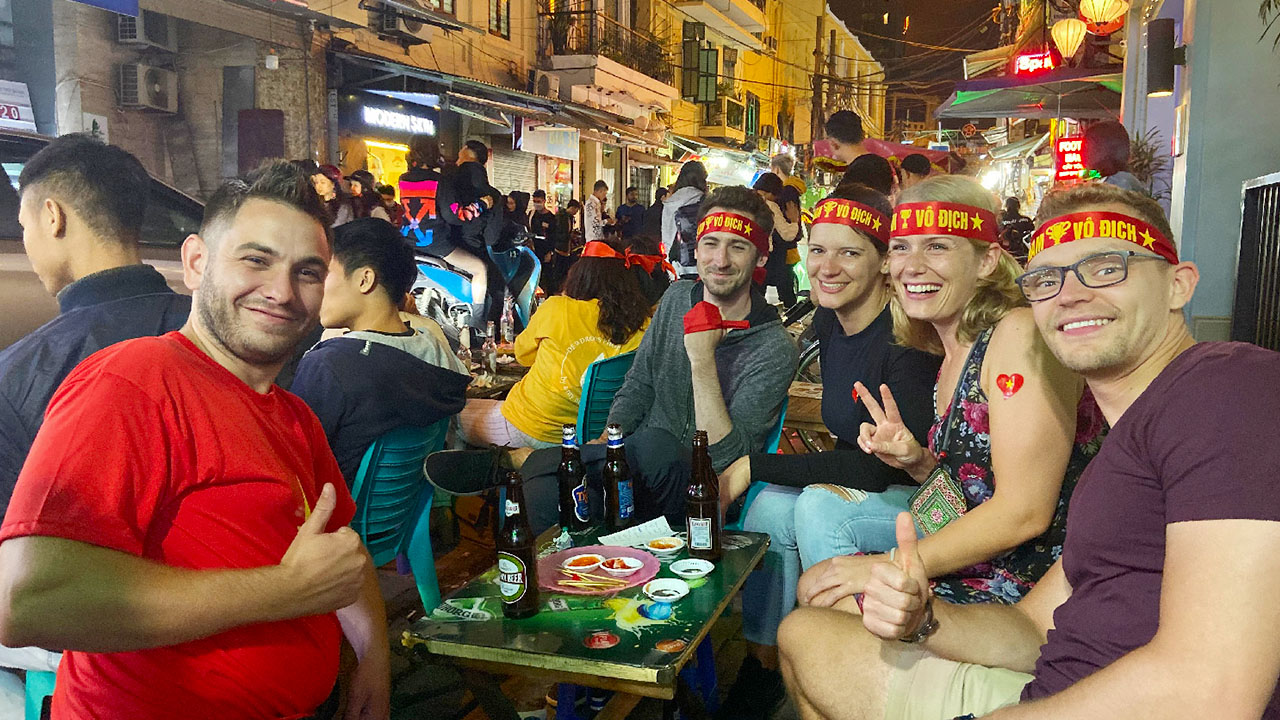
Arriving early has several advantages. If you get to the market around its opening time of 6 pm, you’ll likely encounter fewer crowds. This provides the perfect opportunity to leisurely explore the market, talk to vendors, and enjoy the initial setup without the rush. Early evenings also offer a more relaxed atmosphere, making it easier to navigate and interact with the stallholders.
On the other hand, visiting the market later in the evening, around 9 pm to 10 pm, can also be rewarding. By this time, the market is in full swing, and the energy is palpable. While it may be more crowded, the atmosphere is electric and festive, with street performances in full flow and a vibrant, bustling ambiance. Additionally, vendors may be more willing to negotiate prices as they aim to sell off their remaining stock for the day.
A good strategy could be to explore the market in layers. Start with an early visit to get an overview and identify stalls or items you’re interested in, then take a break to enjoy some street food or performances. You can return later in the evening to make your final purchases and soak in the vibrant, festive atmosphere.
Weather is another factor to consider. Hanoi can be quite hot and humid, particularly during the summer months. Opting for an evening visit when temperatures have cooled down will make your experience more comfortable. Keep an eye on the weather forecast; a cool, dry night is ideal for a stroll through the market.
Weekends around public holidays and national celebrations can see an influx of visitors, making the market even busier than usual. While this can add to the festive atmosphere, it also means heightened crowds and, potentially, higher prices. If you prefer a more relaxed experience, it might be best to avoid these peak times.
In conclusion, timing your visit to the Hanoi Old Quarter Night Market can make a significant difference in your experience. Whether you prefer the quiet calm of the early evening or the vibrant energy of the later hours, planning your visit based on your preferences and the conditions can help you make the most of this lively, cultural attraction.
Safety and security
While the Hanoi Old Quarter Night Market is a generally safe destination, it’s always wise to be vigilant, particularly given the large crowds and bustling environment. Following a few safety and security tips can help ensure a smooth and enjoyable experience.
One of the key concerns is pickpocketing, which can occur in crowded areas. To safeguard your belongings, use a cross-body bag and keep it in front of you. Avoid using back pockets or easily accessible pockets for valuables such as wallets or phones. If you’re carrying a backpack, it might be best to wear it on your front while navigating through dense crowds.
To further mitigate risks, consider utilizing money belts or neck pouches to store important items like cash, credit cards, and identification. These can be worn under your clothing, adding an extra layer of security. When it comes to cash, carry small denominations. Vendors at the market often prefer this as it makes transactions smoother, and you’ll also avoid the risk associated with carrying large sums of money.
Keeping your personal belongings close at hand is crucial. If you’re traveling in a group, designate a meeting spot in case you get separated, as cell phone networks can get overwhelmed by the sheer number of people. Establishing a buddy system can also add an extra layer of security and peace of mind.
Another important aspect of safety is staying aware of your surroundings. While it’s easy to get lost in the excitement of the market, remain cautious, especially in darker or less populated areas. If you feel unsafe or uncomfortable at any point, it’s best to move towards well-lit and busier sections of the market.
Health and sanitation should also be considered. Street food is one of the highlights of the night market, but to avoid tummy troubles, opt for stalls that prepare food fresh on order. Look for vendors with high turnover rates, as this generally indicates fresher ingredients. Carrying hand sanitizer and wet wipes can also help maintain hygiene, especially if soap and water aren’t readily available.
Lastly, always listen to any local advisories or announcements. The market is a dynamic environment, and staying informed about any updates or alerts will contribute to a safe and enjoyable visit.
In summary, a few simple precautions can significantly enhance your safety and security at the Hanoi Old Quarter Night Market. By being aware and prepared, you can fully enjoy the market’s vibrant atmosphere without unnecessary worries.
Currency and payments
Navigating currency and payments at the Hanoi Old Quarter Night Market is a vital aspect of your visit that can significantly impact your shopping experience. Vietnam’s official currency is the Vietnamese Dong (VND), and understanding how to use it effectively at the market will help ensure smooth and hassle-free transactions.
First and foremost, it’s highly recommended to carry a good amount of small bills. Vendors at the night market often lack the ability to make change for larger denominations, making smaller notes more practical. Bills in denominations of 10,000 VND, 20,000 VND, and 50,000 VND are ideal for most transactions. Having plenty of small currency not only facilitates smoother transactions but also aids in better bargaining, as you won’t be held back by the vendor’s inability to break large bills.
While cash is the primary mode of payment, an increasing number of vendors are beginning to accept digital payments through services like Momo or ZaloPay. However, this is more common in urban retail environments than at traditional markets. It’s still a good idea to ask if digital payments are accepted, especially if you find yourself running short on cash. Always double-check the local exchange rates and be aware of any fees associated with withdrawing money from ATMs, which are readily available throughout Hanoi.
For tourists, understanding practical currency conversion can also be useful. As of my last update, 1 USD is roughly equivalent to 23,000 VND, although rates can fluctuate. Knowing this allows you to quickly estimate prices in your home currency and decide what constitutes a fair deal. Consider using a reliable currency conversion app on your smartphone to stay updated on current rates and make quick calculations on the go.
Some vendors might accept foreign currencies like US Dollars, especially for higher-value items, but it’s generally more cost-effective and straightforward to deal in VND. Foreign currency transactions often come with unfavorable exchange rates, so it’s advisable to exchange your money beforehand at a reputable currency exchange service.
When it comes to safe-keeping your cash, using a money belt or neck pouch can provide added security. Avoid flashing large amounts of money when making purchases, and keep your cash organized to facilitate quick and discreet transactions.
In summary, understanding currency and payment practices at the Hanoi Old Quarter Night Market will enable seamless transactions and enhance your overall experience. Carrying small bills, being aware of current exchange rates, and considering secure ways to handle your money will ensure that you can fully immerse yourself in the market’s vibrant atmosphere without any financial hassles.
Conclusion: Embracing the hanoi night market experience
The Hanoi Old Quarter Night Market provides an indelible experience that epitomizes the pulsating energy, cultural richness, and commercial vibrancy of Hanoi. As you walk its bustling streets, you find yourself enveloped in a medley of aromas, colors, and sounds that offer an immersive dive into the city’s spirit.
This market is more than just a shopping destination; it is a cultural crucible where history, tradition, and modernity converge. From the exquisite handicrafts and trendy fashion items to the diverse culinary delights and captivating street performances, the market provides a comprehensive experience that caters to a wide array of interests. Each visit offers something new, whether it’s discovering a hidden talent among the street performers, finding a unique handcrafted souvenir, or tasting a delicious new dish.
Bargaining, far from being a mere transaction, becomes an engaging cultural interaction, a dance of words and gestures that fosters connection and camaraderie between locals and visitors. This aspect enriches the shopping experience, making each purchase more meaningful and memorable.
Additionally, the various cultural exhibitions and traditional crafts on display provide educational insights and opportunities to engage more deeply with Vietnam’s rich heritage. The market serves as a living museum, where one can witness the continuity of age-old traditions while observing the dynamic evolution of contemporary Vietnamese culture.
Practical tips, such as understanding the best times to visit, staying vigilant about safety, and managing currency effectively, enable visitors to navigate the market with ease and confidence. These precautions allow for a worry-free experience, letting you focus solely on soaking in the market’s vibrant atmosphere.
In embracing the Hanoi Old Quarter Night Market, you embrace the very essence of Hanoi itself. It is a microcosm reflecting the city’s diversity, energy, and timeless charm, making it a must-visit for anyone looking to truly understand and appreciate Hanoi. Whether you are a local resident or a tourist, the market offers an unforgettable journey through the heart and soul of this captivating city.


